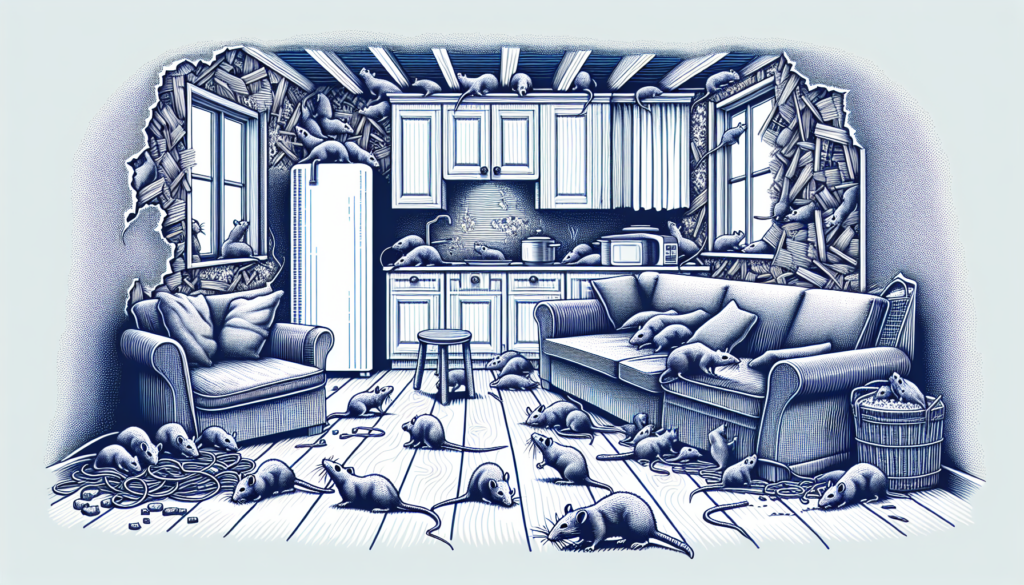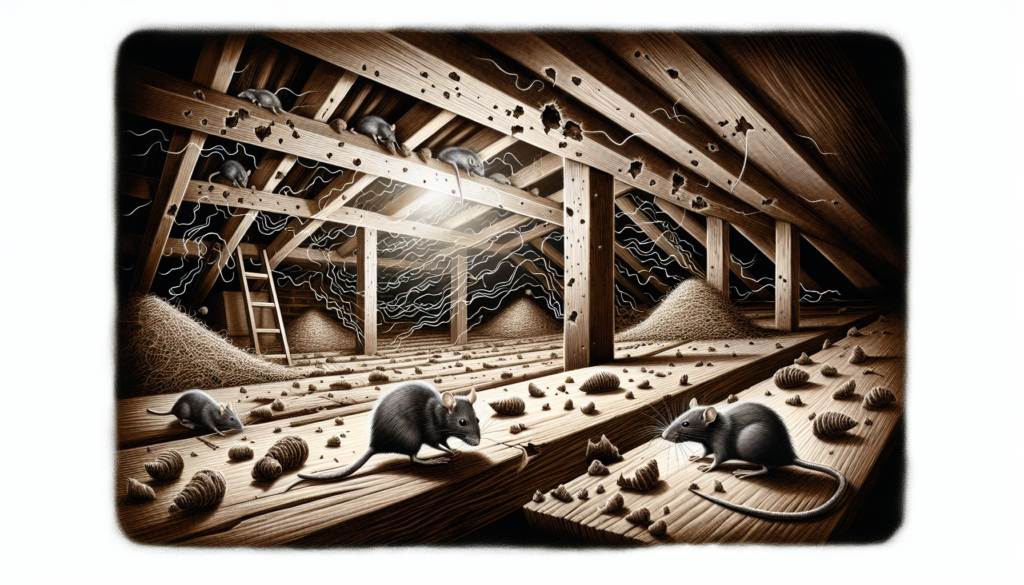7 Safe & Effective Ways To Keep Rats Away
Struggling with a rat infestation can be distressing and hazardous to your health. You need the best way to get rid of rats, and you need it fast. In this article, we’ll reveal seven proven methods to deter and effectively tackle these unwelcome guests. We’ve got you covered, from understanding rat behaviour to employing safe and strategic elimination techniques. Prepare to fortify your home against these pesky intruders without delay.
Key Takeaways
- Rats, including Norway and roof rats, seek shelter in homes due to changes in climate or scarcity of natural food sources. They can rapidly reproduce and are attracted to easily accessible food and water.
- Effective rat control strategies, which include rodent-proofing, proper sanitation, natural predators, traps, non-toxic repellents, regular inspections, and professional pest control services, are necessary to tackle infestations.
- Signs of a rat infestation include droppings, gnaw marks, scratching noises, and nests, requiring timely action to control and prevent potential damage and health risks.
Understanding Rat Behaviour and Infestations

Have you ever felt challenged by rat control? Their unique behaviour patterns are the key reason. Rats, particularly brown rats, the Norway rats and roof rats, are opportunistic creatures. They tend to invade our homes when the temperatures drop, and their natural food sources become scarce. But, don’t be fooled by the common misconception that rats are always on the lookout for food. Despite their varied diets, these rodents are known for their resilience and won’t easily starve.
However, this doesn’t mean they won’t take advantage of a free meal if they can find one. Their ability to adapt and survive is what makes them such formidable pests. These nocturnal creatures have acute senses and a natural curiosity, which, coupled with their aversion to new things, makes control efforts a complex task.
However, rat behaviour extends beyond their intelligence and caution. everything attracts rats. Their social nature and rapid reproduction rates further complicate matters. If you spot a rat, chances are, there are more hiding nearby. With female rats capable of producing up to 5 litters per year, each with 6-12 offspring, it’s not hard to imagine how quickly a few rats can morph into a full-blown infestation.
Intelligence and Caution
Rats are equipped with an impressive level of intelligence that can make some control methods, like ultrasonic-repellent devices, less effective. They display obsessive behaviours and habits while also being inherently curious, making control efforts complicated. Their highly sensitive sense of hearing, capable of detecting noises up to around 90,000 Hz, may also influence the efficacy of certain repellents.
Their intelligence and caution combined make it hard to fool them. They are quick to adapt and learn, making the task of removing them a challenging one. Understanding their behaviour becomes crucial for successful control due to their formidable intelligence.
Social Nature and Reproduction
Rats are not solitary creatures. They thrive in social groups, and if you spot one, there is a high likelihood that there are more lurking nearby. Their social rat behaviour also influences their reproduction habits, making rat and bait stations an effective solution for controlling their rat population. It’s important to remember that rats carry diseases, so controlling their numbers is crucial for public health.
Here are some key facts about rat reproduction:
- Female rats can reach sexual maturity in as little as five weeks
- Female rats can produce up to five litters per year
- Each litter can have 6-12 offspring
The rapid and frequent reproduction of rats underscores their potential to grow from a small group into a large infestation quickly. A female rat can reproduce up to 500 times in just six hours, potentially leading to 2,000 offspring in a year, with litters of wild rats sometimes holding up to 22 young. This underlines the need for regular inspections, as unchecked rat colonies can swiftly transform a minor issue into a major infestation.
Attraction to Shelter and Food
The main reason rats enter homes is to seek shelter. To minimise shelter opportunities for rats, it’s important to keep things like woodpiles elevated and distant from the house and manage vegetation around the property. In addition to shelter, rats are also drawn to homes by the availability of food sources, especially human food, dog food, bird feeders, seeds, and garbage.
Although rats prefer cereal products, they are omnivorous and will consume a wide variety of foods, including other small animals. In addition to shelter and food, rats are also attracted to homes by the availability of water and conducive environments. Thus, addressing these factors involves maintaining food storage security, removing potential food waste, and reducing access to water sources.
Seven Safe and Effective Methods to Deter Rats

Equipped with an understanding of rat behaviour, we can now address rat infestation directly. There are seven safe and effective methods to deter and eliminate rats:
- Rodent-proofing your home
- Maintaining proper sanitation and waste management
- Utilising natural predators
- Setting up rat traps
- Conducting regular inspections and monitoring
- Seeking professional pest control services
These methods are not just effective but also safe for use around homes with children or pets. They range from simple preventive measures that you can implement yourself, to more intensive control methods that may require the help of professionals. Each method offers a unique approach to the issue, targeting different aspects of rat behaviour and habitat. Some of the methods include:
- Sealing off entry points
- Removing food sources
- Trapping and removing rats
- Using rodenticides
- Calling in professional pest control
By combining these methods and debunking rat control myths, you can effectively control rats and get rid of rats in your home.
We’ll examine these methods in more detail, understanding their operation and advantages. Armed with this knowledge, you will be better equipped to select the most appropriate strategies to combat any rat problem you may be facing.
1. Rodent-proofing Your Home
Making your home less accessible to rats is the initial step in deterring them. This can be achieved through a process known as rodent-proofing. Start by sealing small holes using steel wool and caulk to prevent rodents from entering your home. Don’t forget to inspect areas around utility lines entering the home, such as electrical, water, and gas services, and seal any openings you find.
Additionally, trimming back or removing climbing plants like ivy and wisteria from walls and below the roof line to eliminate climbing aids for rats. For broader rodent-proofing, use robust materials like lath metal, cement, or hardware cloth to patch larger openings in the home’s exterior. By making it more difficult for rats to find a way into your home, you’re reducing the chances of an infestation.
2. Proper Sanitation and Waste Management
Maintaining proper sanitation and waste management is vital in keeping rats at bay. Here are some tips to prevent rats from accessing food:
- Store kitchen waste in bins with tightly sealed lids
- Manage compost effectively
- Store food in sealed containers
- Avoid leaving bird food residue, which may also feed rodents
Following these practices can help avoid actions that attract rats and keep them away from your property.
In addition to managing food waste, it’s also important to remove potential nesting sites. This can be achieved by removing accumulations of leaves, trimming back thick mulch, and covering compost heaps in the garden. Lastly, eliminate sources of standing water, as they can make your property less attractive to rodents seeking a water supply. Remember, sanitation is a key aspect of controlling rats as they thrive where there is abundant food and shelter.
3. Natural Predators

Leveraging natural predators proves to be an effective way to manage rat populations. Owls, birds of prey, and housecats are among the natural predators that can help manage rat populations. By encouraging the presence of these predators in your environment, you can create a natural and sustainable form of pest control.
4. Rat Traps

Rat traps are a traditional method of eliminating rats from your home. Snap traps are considered one of the best options for quickly eliminating rats, and peanut butter is recommended as an effective bait. If you know the rats’ food source, using it as bait in snap traps might yield better results.
Electronic rat traps offer a safe and humane solution by instantly electrocuting rats without the use of poisons. They are considered the only method that kills rats instantly, providing an effective and quick result.
The traps are less effective with adult rats due to their level of intelligence.
5. Regular Inspections and Monitoring
Conducting regular inspections and monitoring is pivotal in averting and managing rat infestations. Regularly setting up live traps with bait is an effective method to monitor for signs of rat activity. Additionally, foot and tail marks in dusty, less-used areas of a home can indicate rat presence.
To confirm an active infestation, try sprinkling fine flour or talc near suspected rat footprints and checking for fresh tracks the next day. Regular inspections and monitoring can help you catch a rat infestation early, allowing you to take action before it gets out of hand.
6. Professional Pest Control Services
Should DIY methods prove unsuccessful or if you’re uncertain about rodent elimination, seeking professional assistance is recommended. In such cases, contact a pest control technician immediately. Professional pest control services, such as those provided by BPCA member companies, possess the technical knowledge and experience to apply products efficiently, minimising risks to the environment and non-target species.
Pest control professionals follow a systematic approach to eradicate rat populations, which includes inspection, treatment, and exclusion steps. By leveraging their expertise, you can effectively and safely eliminate rat infestations from your home.
Identifying Signs of Rat Infestations

Recognising the signs of rat infestation paves the way towards a rat-free home. Rat infestations are commonly indicated by physical evidence such as:
- Droppings: small but larger than a grain of rice, dark, and pellet-shaped, can be found in areas like cupboards, behind appliances, or in dark corners , although rats are very clean and will usually have a toilet area
- Gnaw marks: on wood, plastic, or electrical wires
- Scratching noises: coming from walls, ceilings, or floors
- Nests: made of shredded materials like paper, fabric, or insulation
If you notice any of these signs, it’s important to take action to eliminate the rat infestation and prevent further damage to your home.
The presence of gnaw marks on food packaging, wood, or wires can signal an active rat problem. Additionally, greasy smudges or grease marks along walls and surfaces indicate habitual paths and rat movement patterns within a building. Footprints or tail marks in dusty areas, along with regular paths through grass or low vegetation, help identify rat runs and movement.
Droppings
The presence of rat droppings, or even a dead rat, often clearly indicates a rat infestation. The shape, size, and colour of rat droppings can help identify the type of rodent and the severity of an infestation. Fresh rat droppings are dark and moist, whereas older droppings appear grey and dry.
The presence of fresh droppings indicates an active rodent infestation. Signs of a healthy rat infestation include active rat droppings and grease marks along walls and floorboards. By closely inspecting for these signs and the presence of dead rodents, you can better assess the extent of a rat problem in your home.
Gnaw Marks
Gnaw marks can also act as a potent sign of rat activity. Rats gnaw on materials like plastic and wood, which can be identified by the large, rough teeth marks they leave behind. These gnaw marks are not just a nuisance but can lead to significant structural damage when rats gnaw on building materials.
Gnaw marks can be found on various surfaces, from food packaging to wood and wires. Identifying these marks can help you gauge the extent of a rat infestation and aid in developing an effective control strategy.
Scratching Noises
Scratching or scurrying noises in a home often suggest a rat infestation. These noises are typically heard coming from walls, ceilings, or floorboards. Because rats are nocturnal, these sounds are often more noticeable at night. If you hear these noises, it’s time to inspect your home for other signs of rat activity.
Nests
The existence of nests is another unmistakable sign of a rat infestation. Rats build nests using a collection of shredded material, often found in secluded areas of your home. Norway rats typically nest in burrows, often found in the ground, while roof rats prefer to nest in elevated areas such as lofts, attics, and other dark, less frequented parts of a home.
Identifying the types of nests and their locations can provide important clues for effectively targeting and eliminating rat infestations. If you suspect a rat infestation, be sure to examine your home closely for these signs.
Summary
We’ve journeyed through the world of rats, understanding their behaviour and infestations, and exploring six safe and effective methods to deter them. From understanding their intelligence and social nature to employing various methods such as rodent-proofing your home, utilising natural predators, and seeking professional pest control services, we’ve covered a wealth of strategies to reclaim our peace from these pesky invaders.
Remember, knowledge is power. By understanding rats and their behaviours, you’re better equipped to prevent and tackle rat infestations. Armed with these strategies, you are now prepared to take a stand against these unwelcome visitors, ensuring a cleaner, safer, and rat-free environment for you and your loved ones.